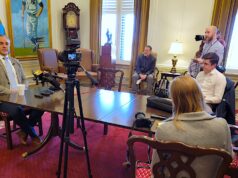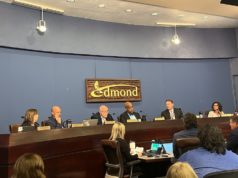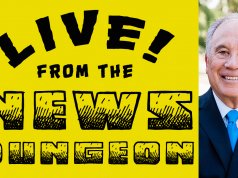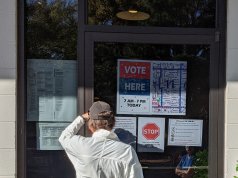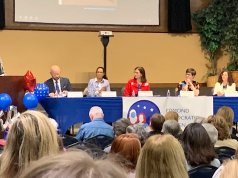
On St. Patrick’s Day, the NonDoc team published a lengthy screed that I had penned about the disaster that is the Oklahoma state budget. I was just blowing off steam after some green beers, but thousands of you opened, read and commented on my tome. Thank you for all the positive remarks, but for those who commented negatively, you will notice you are no longer my friend on Facebook.
Anyway, the green beer-inspired analysis established (rather convincingly, I thought) that 70 percent of a disastrous $1.3 billion shortfall in next year’s state government budget has absolutely no relationship to oil price declines but everything to do with ridiculous tax cuts and bad fiscal management.
Thoughtful people understand that the Tea Party and the Republicans fully own this catastrophe that we are seeing unfold in Oklahoma.
Oh, wait: I have just been handed The Oklahoman’s March 25 editorial. This lead editorial invested two columns of vitriol directed at Rep. Mike Brown (D-Tahlequah) for having the audacity to suggest that perhaps there was more to the state’s budget deficit than a drop in oil and gas rates. But the editorial’s point is that if Oklahoma’s budget issues are not oil-and-gas- related, why are other producing states having problems?
Editorial oversight
Apparently, Google is not the friend of busy editorial writers. A check of the eight states mentioned suggests that any of those with problems similar to Oklahoma have all been experimenting with whacking taxes dramatically and seeing if they can get that trickle-down thing going.
RELATED
David Walters: Partisan ideology takes its toll on budget by David Walters
The editorial, however, provides some interesting statistics. First, the writer states, “Alaska alone faces a $3.5 billion shortfall.” Now there is an interesting state to cite as an example. Shortfall or no, Alaska will spend $10 billion next year on a population of 750,000, or $13,300 per capita. Meanwhile, Oklahoma will spend $5,052,903,464 on a population of 3.9 million, or $1,296 per capita. So, Alaska will spend 10 times more than Oklahoma!
Most interesting, the editorial states that, of the eight states in which oil and gas exceeds 10 percent of the state’s GDP, the average “associated severance taxes accounted for 16 percent of tax revenue in those states.”
Really? Sixteen percent? Guess what the total gross production tax is forecast for next year in Oklahoma: $65 million. In a budget of $5 billion, that is only 1.2 percent, not 16 percent.
If Oklahoma collected the national oil producing state average of 16 percent of its tax revenue from oil and gas, it would be collecting at least $800 million dollars more than it does today.
Shame on us
The oil and gas companies did not invent this rich resource. God put these resources under our feet. If you are not religious, then consider that rotting dinosaurs did us a favor in selecting where they chose to die.
Follow NonDoc:
We allow oil and gas companies to take this treasure out of the ground and become incredibly wealthy for it. They say they make money because they take incredible risks. Well, who in business doesn’t take risks? Come to Pakistan with me or to West Africa sometime on an electric power plant project, and I will show you business risk that will curl your hair. Yet these companies pay hardly any gross production taxes on riches they made from our resources.
What a mess. Thank God for Mississippi, right?
Wrong.
News flash: Mississippi’s budget this year went up a quarter of a billion dollars, and they have half a billion dollars in reserve. Mississippi now spends $6.2 billion on a population of 2.9 million people. By contrast, Oklahoma’s budget next year of $5.05 billion dollars will be spent on 3.9 million people. Let me help you with the math: Mississippi’s state government spends $2,138 of state funds per capita, and Oklahoma spends $1,296. Mississippi spends 65 percent more per capita than Oklahoma on state government services. Now, the politicians in Mississippi are saying, “Thank God for Oklahoma.”
How to fix the budget
By the way, balancing our budget and getting it fixed is not that hard if you have reasonable people in charge who are serious and actually want to solve the problem — two conditions sadly lacking in the current Legislature.
Here is my to-do list for fixing the state budget:
| How to Balance FY2017 | Annual Savings (millions) |
| Leave FY2016 midyear (7%) Cuts in Place | $413.0 |
| Redirect the Increase in Road Funds | $46.6 |
| Appropriate Balance of Rainy Day Fund | $315 |
| Accept Medicaid Expansion | $150 |
| Forestall Income Tax Cut | $147 |
| Eliminate Double Deduction of State Taxes | $97 |
| Adopt Amazon Laws on Internet Sales | $75 |
| Adopt Combined Corporate Reporting | $50 |
| Total Cuts and Revenue | $1,293.6 |
There are many other options (gas tax, tobacco tax, sell some assets and endow the proceeds for education, etc.). This is not rocket science, just basic math and a desire to do good.
The right time to run for office
The Tea Party and the Republican Party (the Teapublicans) own this disaster. They have had the dominant majorities and inherited a responsible budget that made ends meet (barely), and they then wreaked havoc on the place. They and The Oklahoman seem to be getting away with blaming it on an oil-price drop. I imagine that many of the Teapublicans go to bed every night praying that they are not found out, but even worse I fear many of them go to bed every night proud of the wreckage they have created. One of their leaders in a forum in Tulsa said it was an opportunity to “right size government.”
So, if you ever wanted to run for office, this might be a good time. Oklahoma really needs good candidates — in all races. Let me tell you why I underscore this point. In the 2014 election, a Democrat did not file for 75 offices up for election, including:
- one Congressional seat (Tulsa)
- five statewide seats (Attorney General, Treasurer, Auditor, Insurance, Corporation Commissioner)
- 12 District Attorney seats
- 10 state Senate seats
- 47 state House seats
Of all the races on the ballot, 48 percent had only one person file, and 62 percent of all the offices on the ballot were decided before the general election. Then, voter turnout amounted to about 10 percent of voting-age adults in Oklahoma.
No one runs and no one votes. My dad used to say, “If you don’t ask for it, you don’t get it.”
Now, I don’t want you to think that I am only advocating for more Democrats to run. I am advocating for serious-minded men and women who want to solve the problem, want better public schools and want greater access to health care and a higher level of public safety. It has just been my experience over the last 50 years that such people more often than not turn out to be Democrat.
When the public realizes the collapse of public education, health care, public safety and much more, when they see this in the daily headlines and on the news and when they hopefully make the connection that they voted for the people responsible, this will be a more powerful political wave than you can imagine.
When it happens, I hope you are standing there with your candidate filing form and surfboard, ready to ride the wave and fix this mess.
[Drops mic.]











